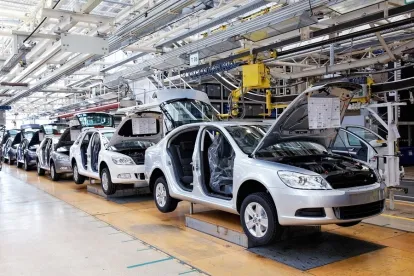Like many industries, the automotive sector was hard hit by COVID-19. With plant closures, retooling of manufacturing lines for the production of necessary personal protection equipment, and the declining purchase demand for new vehicles, the automotive industry has a tough road ahead of it in order to return to the glory it enjoyed before the coronavirus pandemic befell the world. While reopening the plants and retooling the manufacturing lines to produce vehicles once again is a good start down, it appears that operating in the same manner as before the pandemic is not necessarily the best strategy for success. As the industry restarts, it should consider new health and safety protocols, disruptions to the supply chain, and altered consumer spending habits and purchasing power associated with historic high unemployment. Even accounting for these considerations, restarting operations is not enough. To be successful, the road to recovery is a complicated trip through a long path of transformation.
There are short-term considerations that automotive companies should consider now, such as cash management, employee health and safety, workforce training, retooling and recalibrating operations that were either dormant or have since transitioned to the production of needed personal protection equipment. Change and innovation will be necessary for the automotive sector to fully and successfully recover from the disruption caused by the coronavirus. This includes real reform and reimagining the automotive sector in order to best protect against another global pandemic and other events once considered too esoteric and academic to plan for. We will tackle some of these in upcoming notes. This note focuses on the impact social distancing is having on the consumer automotive market. Failure to embrace the socially distant sales process may well ensure that one's sales become distant.
Here are some innovative considerations that automotive companies may wish to examine while contemplating how they will return to pre-pandemic operations while surviving and flourishing in the post-coronavirus world:
Embrace the online world
One thing this pandemic has shown us is that people have adapted relatively quickly to the virtual world. Shopping, especially for big-ticket items, has always been an activity with an in-person preference. While some automotive companies have created an online sales environment, complete with customization and inventory control, they have been the exception and not the rule. Consumers are now embracing online sales at a pace never seen before. Whether for convenience, safety, or a myriad of other reasons, online shopping is becoming mainstream for even the largest of purchases. While a portion of the population will return to the showrooms, a sizable portion of the population will now be looking for a complete online solution, from discovery to customization to purchase, delivery and service. This entire process should take just a few clicks from end-to-end; otherwise, potential customers may lose interest before completing the sale. Ignoring this will likely materially shrink one's potential customer base. With the state of augmented and virtual reality today, there is no reason why these technologies are not deeply embedded in the sales process, providing potential buyers a fully immersive sales experience. Of course, potential buyers may appreciate any technology that eliminates the pushy salesperson and the negotiations. So, think twice about that chatbot or virtual assistant to avoid aggravating shoppers.
After-Sales Support
This online experience should not start and end with the car buying experience. It should extend throughout the consumer's relationship with their vehicle, encompassing after-sales support and service. The ability to diagnose and schedule service appointments online and via an app is critical. However, the experience should not stop there. Being able to go online and connect with the car's hub, allowing the owner and the service center real-time insights into the car's health is critical for preventative maintenance. There are already several artificial intelligence-based programs to aid in this effort. Allowing such programs access to a car's information can be game changing. At this point, most consumers are reasonably comfortable with online payment and in-app purchases. There is no reason why payment cannot be moved to a fully online process as well. One should be able to schedule their service appointment, including drop-off and pickup, all via an app with just a few taps of a finger. This online world will enable a more accessible auto parts and after-market accessories environment, increasing a consumer's spending potential and yielding higher profitability. While this socially distant approach may feel like creating a disconnect between the consumer and dealership or service center, it is just the opposite. While many individuals crave direct social interaction in everything they do, many surveys indicate that people are looking to implement socially responsible distancing strategies into their lives.
Data
There is another, less obvious, but more powerful benefit from this online, interactive environment, and that's information. After all, data is king and knowledge is power. With each additional interaction, more data is collected, and more significant insights are possible, creating a massive feedback loop. In turn, this permits greater personalization and just in time messaging, increasing the possibility of consumer interaction, leading to increased conversion and purchases of products and services. Personalization not only enhances the immediate experience but also plays a significant role in helping to ensure the consumer returns for future purchases as well.
Purchasing Models
While there are some niche players, primarily, car ownership is purchase or lease. With consumers gaining comfort with subscriptions, pay as you go, upgrades and substitutions, getting consumers to consider a new model for car acquisition is no longer science fiction, but rather, fact. If the costs are accounted for, there's no reason why consumers could not, with a few simple taps and swipes, subscribe to cars, allowing greater flexibility on what car they drive, and when. It may allow someone to drive a sports car one day, then when needing to carpool, select a 7/9 seater, or pick up supplies at the hardware store and selecting a pickup truck. The possibilities are endless. For example, one can extend one's ownership of a car they enjoy, return a car they no longer enjoy, and swap cars for various other needs, all with the tap of a finger.
The consumer automotive sector is a prime example of an industry that is ripe for innovation to create fully immersive, interactive, and meaningful engagements, encouraging more significant interaction, and allowing for more touchpoints. Imagine, a more connected relationship, giving one the sense of community and creating rich and meaningful connections, yet, remaining physically distant. It’s possible to feel more connected while physically apart through technology and respecting the desires of many to limit physical encounters, at least for the time being. If done right, one may be able to innovate a way to make car buying somewhat of an impulse purchase. Right now, innovation is key to finding a secure footing amongst these uncertain times. Socially distant innovation may be the key to recovery and lay the foundation for creating a more resilient and adaptable automotive industry.




 />i
/>i

